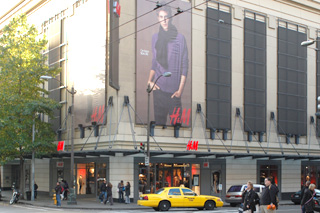
Surveys
DJC.COM
December 11, 2008
Local retailers will fare better than others
Cushman & Wakefield

Detmer
|
All of us are concerned about the state of the economy and the lackluster sales trend so many retail businesses are experiencing. The headlines are ominous: Circuit City files for bankruptcy; Shoe Pavilion shutters stores; Linens-N-Things liquidating inventory; Retailers brace for the most challenging holiday in three decades. It is hard to find any good news. Yet, good news will be on the horizon.
A CEO of a retail chain once said to me, “Trees don’t grow to the sky.” What did he mean by that? When the economy is booming and retail sales are well above last year’s levels on a comparable store basis, the demand for retail real estate increases, availability decreases, there’s competition for each space and lease rates go up. However, lease rates cannot rise for infinity.
Just as a tree does not continue to grow until it reaches the stratosphere, so too must lease rates stay at an earthly level.

|
It is safe to say that virtually no retailer can make money if their rent exceeds 10 percent of their sales. Some retailers cannot afford to pay even half that amount. Savvy retailers always keep their occupancy cost at the top of mind and make real estate decisions accordingly. Less successful retailers might believe that though occupancy costs are high initially, once business grows, everything will be all right. But sales do not always escalate.
In the home mortgage business, we had “statement loans” where borrowers backed into the amount they made on an annual basis in order to qualify for the loan (and house) they wanted. In retail commercial real estate, we all saw a few pro formas that looked a lot like statement loans. Some retailers backed into the sales they needed to achieve to be able to afford the real estate they wanted. As an example, a retailer whose average sales were $300 per square foot might project sales of $400 for a new store in order to justify rents of $40 per square foot.
Developers needed high rents to justify the ever-increasing construction costs.
Low vacancy here

Photo by Benjamin Minnick Seattle is still being discovered by international retailers such as clothier H&M. |
In the Puget Sound area, we are particularly blessed. We’ve experienced some of the lowest retail vacancy levels of anywhere in the country for more than 10 years.
Vacancy rates in Western Washington are well below the rest of the country because of our barriers to entry. Our cities are adjacent to large bodies of water, we have mountains, narrow land corridors off of our interstate highways, and limited amounts of land available for retail development. All of those factors result in demand for retail real estate that exceeds supply.
International Council of Shopping Centers research shows this area to have significantly less retail square feet per capita than the country average (by more than 10 square feet for every man, woman and child).
Though we will be affected by this economic slowdown, we will not experience nearly the vacancy levels or lease rate decline that will occur in other areas of the country.
So what is happening now? Consumers are tightening their budgets and retailers are experiencing sales declines. Those that overpaid for real estate are in trouble. Those retailers that counted on continuing increases in sales to justify their lease rates are in trouble.
We will see more retail vacancy after the holidays, in the first quarter of next year. We are already seeing more space available in the mid-size retail box arena (spaces of 20,000 to 40,000 square feet) than there has been in years.
Attracting new retailers
Throughout all of this turmoil, there are and will be clear winners. In the void created by failing retailers, there will be new retailers that emerge and grow because of the temporary excess of space that allows new concepts to come to market at lower lease rates. Retailers that are successful in other areas of the country might finally be able to secure a Puget Sound location.
At the risk of dating myself, I remember my acute sadness as each of the following retailers closed their doors locally: Frederick & Nelson, I. Magnin, Jay Jacobs, Lamont’s, Egghead Software, Incredible Universe, Ernst, Pay ‘n Save, Garden Botanika, and FAO Schwartz.
Yet the list of retailers new to our market in just a few short years is even more remarkable. Ten years ago, who among us would have thought a 6,000-square-foot Apple Store would exist, or remember having only department stores or drug stores for your cosmetic purchases before Sephora and Ulta Cosmetics? H&M has transformed how the young customer shops. Crate & Barrel and Pottery Barn help set the fashion direction for our homes. And who doesn’t love DSW (Designer Shoe Warehouse)?
Many stores from yesterday have evolved into something new and better. Bowling is evolving into a nightclub alternative. The Bon became Macy’s. The Gap went from a store selling 100 percent Levi product in the 1970s to several iterations of fashion between then and now. And Nordstrom just gets better.
The Pacific Northwest has always been a breeding ground for successful retail concepts. Sur La Table, InSpa, Eddie Bauer, Butch Blum, Fireworks, Gene Juarez, Joe’s, Jeri Rice, Metropolitan Market, Mario’s, Mrs. Cooks, Nike, Nordstrom, Pallino Pasteria, REI, Sleep Country USA, Starbucks, Tully’s, Storables and Zumiez all got their start in our neck of the woods. Successful retailers continue to evolve, and must evolve, in order to stay current and relevant to consumers.
Despite Seattle being somewhat protected from the worst of the economy, I believe we will see sluggish retail sales this holiday. Some retailers will close their doors and we will experience retail vacancy of over 10 percent in some parts of Puget Sound through the first half of 2009. Other areas of the country are forecasting vacancy rates of 20 percent and more.
The good news? Seattle will remain underserved, from a retail space perspective, for years to come. Trees may not grow to the sky, but Seattle is a key U.S. market and every successful retailer would like to have a presence in our town. I can’t wait to see the new retailers that emerge from this challenging economic climate.
Susie Detmer is senior director of retail services for Cushman & Wakefield. She has been in the retail industry for three decades.
Other Stories:
- CBA speakers take on the economy
- A green future for savvy developers
- Making green design deliver ROI, not just LEED
- Market District evolves as a walkable neighborhood
- Mixed-use projects can pay off handsomely
- Suburban hubs will draw tomorrow’s renters
- Seattle’s office market: No more high-fiving
- Industrial market hums along, but don’t hold your breath
- CBA ready to mint a new breed of green brokers
- Weathering the storm
- Young guns take their shot at the market
- David A. Sabey
Sabey Corp. - Sean G. Hyatt
Trammell Crow Residential - Lynn Michaelis
Weyerhaeuser Co. - Dan Ivanoff
Schnitzer West - Commercial real estate prepares for the future
- The pitfalls of renting out condo projects
Copyright ©2009 Seattle Daily Journal and DJC.COM.
Comments? Questions? Contact us.